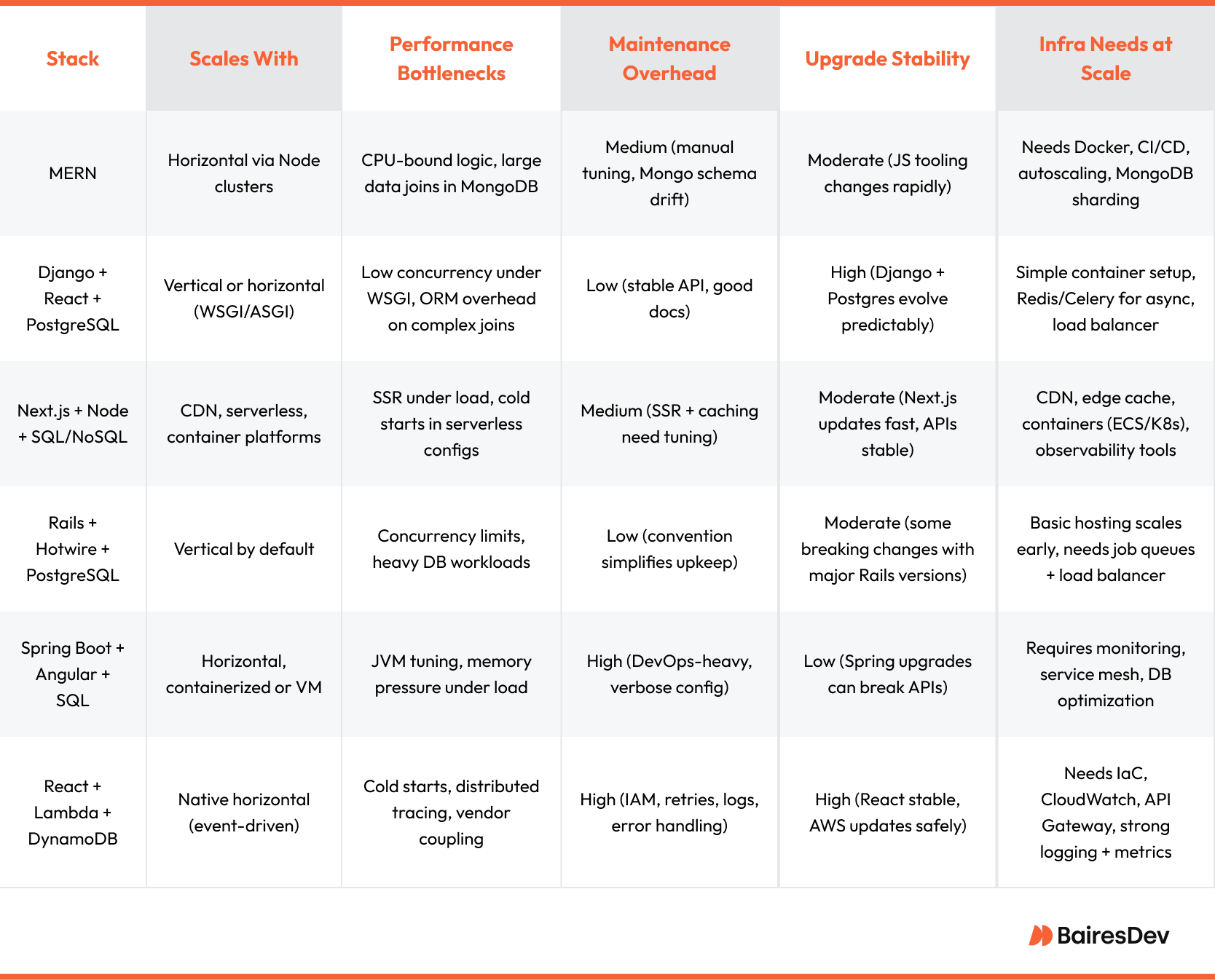Your initial tech stack choice quietly shapes everything from system design to the pace you can keep over time. The tricky part is, the impact doesn’t always show up right away. Take AirBnB’s shift from a monolithic architecture to microservices. It’s proof that what feels right at launch can eventually get in the way as things scale.
In this guide, we’ll show you what you need to make the right calls. We’ll cover how to assess your requirements, walk through some of the software development best practices and most common tech stack combinations, and dig into what it takes to scale and keep things running long term.
Assessing Your Requirements Before Committing
Before you start comparing frameworks or debating databases, take a step back. You can’t make informed decisions about your tech stack until you’ve clearly defined the product scope, the capabilities of the team building it, and the scale and complexity it needs to support over time.
Define What You’re Building
Start by clearly articulating the product’s purpose, target users, and expected interaction patterns. A tool built for internal analysts demands a different level of system stability and operational predictability than a customer-facing platform, where performance degradation is immediately exposed at runtime.
Then, consider the product’s intended lifespan. Is this a short-cycle MVP that may pivot quickly or a foundational platform designed to scale and evolve over several years? Short-term products often benefit from rapid development frameworks, while long-term systems demand more durable and modular architecture.
Finally, map out how the product is expected to evolve. If the scope is tight, the system might stay lean. However, if expansion is on the horizon, whether through new capabilities or tighter platform connections, you’ll need a stack that can scale without forcing you to constantly refactor or rethink the software architecture.
Team Capabilities and Delivery Pressure
Make sure to evaluate your team’s current strengths. Because, at the end of the day, technology decisions are shaped by the people doing the work and the time available to do it. Early delivery tends to move faster when a team already knows the stack. But that advantage only goes so far. Any gaps could easily complicate critical build stages if the roadmap introduces unfamiliar tooling or architectural patterns.
Then, factor in time pressure. Quick delivery often depends on familiar tools, even if they’re not the best long-term fit. On the other hand, if timelines are flexible, it might be worth investing in a more future-proof stack despite higher upfront effort in terms of onboarding and ramp-up.
Plan for External Demands and Long-Term Viability
Once you’ve defined the product and the team behind it, it’s time to think beyond your own walls. Ultimately, your stack needs to support real-world constraints like budget, compliance, integrations, and long-term support. And if you overlook these external demands early on, you’re setting yourself up for issues that won’t surface until you’re already too deep in.
Start with a total cost of ownership across core components:
- Licensing fees
- Infrastructure and hosting bills
- Paid tools or vendor lock-in
- Maintenance overhead when knowledge is siloed
Once that’s mapped out, shift the focus to security and compliance. In regulated environments like finance or healthcare, your systems must demonstrate how actions are recorded, define clear boundaries for data usage, and follow the processes your legal team signs off on. However, you’ll need to also remember that since standards evolve—what meets today’s benchmarks may fall short as regulations shift over time.
Integrations matter, too. Most systems depend on upstream and downstream communication, often involving legacy environments or distributed services owned by other teams. When your stack introduces friction in that exchange, every new integration becomes a time sink and a potential failure point.
And finally, long-term maintenance. This depends on how sustainable the stack is under active development and through periods of team turnover. Not to mention that without clear ownership and predictable upgrade paths, reliability and operational stability can erode over time.
Comparing Popular Tech Stack Combinations
You can absolutely build your own tech stack from the ground up, and sometimes that’s the right call. But most teams don’t have the luxury of endless time or custom integrations. They need to move fast while avoiding unexpected compatibility issues and relying on talent that doesn’t require weeks of onboarding. That’s precisely why many lean toward established stack combinations built around components—frontend, backend, database, and infrastructure setups already proven to work well together.
1. MERN Stack (MongoDB + Express.js + React + Node.js)
MERN is a full JavaScript stack often used for building responsive single-page apps and quick-turnaround prototypes. More specifically, React handles the UI layer on the client side, while Express and Node run the backend logic and server-side APIs. MongoDB rounds it out with a flexible document store that’s well-suited for evolving data models.
Here, since context switching is minimal and onboarding tends to be faster, it’s well-suited for small teams that need to ship quickly without heavy backend overhead.
Of course, you don’t need to stick to the full MERN stack if it doesn’t suit your architecture or scaling needs. Take Netflix, for example. They use React on the frontend for the main app, but internally they’ve used Node.js and even MongoDB for tooling, internal dashboards, and prototyping interfaces.
2. Django + React + PostgreSQL
This one’s a reliable full-stack setup that balances development speed with long-term stability. Here’s how the parts work together:
- Django provides a structured Python backend with built-in tooling, such as ORM, admin dashboards, user authorization, and routing.
- PostgreSQL stores relational data with strong consistency and support for complex queries. It strongly fits projects that demand reliable data handling and reporting.
- React powers the frontend with a flexible component model while enabling rich UIs and dynamic user experiences.
Together, these layers enable fast builds while still supporting the kind of structured and data-driven workflows typical of internal operational platforms.
3. Next.js + Node.js + PostgreSQL or MongoDB
This stack centers around Next.js, a React-based framework that combines frontend and backend logic into a single runtime. It supports server-side rendering (SSR), static site generation (SSG), and API route handling, which ultimately simplifies infrastructure for full-stack applications.
Node.js serves as the execution layer for both server-side logic and rendering.
PostgreSQL is often chosen for this setup when the application depends on structured relationships and reliable transactional behavior. However, MongoDB is usually the better fit for use cases with more flexible and document-oriented data.
Such architecture suits applications that need fast initial loads and dynamic content handling, like SEO-sensitive web apps or hybrid-rendered SaaS products.
4. Ruby on Rails + Hotwire + PostgreSQL
This modern Rails setup is built for speed and simplicity.
Hotwire replaces the need for complex JavaScript frameworks by handling interactivity through server-side updates over WebSockets or HTTP. This means you’d be getting reactive interfaces without managing a full frontend stack. Rails uses convention to reduce decision fatigue, letting teams build quickly with consistent structure and built-in support for key backend functions. Then, PostgreSQL anchors the backend with strong relational capabilities and consistent transactional behavior.
It’s a stack that works exceptionally well for fast iteration without the overhead of managing fragmented frontend and backend layers. It keeps everything cohesive, from data models to UI updates, without trading off development speed.
Project management platform Basecamp, which created Hotwire, runs this exact stack in production and promotes it as a productivity-first full-stack setup.
5. Spring Boot + Angular + MySQL or PostgreSQL
This is one of the most established stacks in enterprise environments that prioritize long-term stability with structured layers and tight security controls. That said, it’s still very much widely used to build secure and maintainable systems in sectors with strict regulatory demands like finance, healthcare, and logistics, among others.
Here, Spring Boot handles the backend with a modular, annotation-driven approach that makes API development and service orchestration clean and scalable. Angular, with its strong typing and structured architecture, helps teams build predictable and maintainable frontends (a big advantage when several developers are working on the same codebase). For persistence, MySQL or PostgreSQL offer dependable relational storage with ACID compliance while supporting transactional workflows and complex business logic.
4. Serverless Stack (React + AWS Lambda + DynamoDB)
This serverless architecture setup trades traditional infrastructure for a fully managed event-driven model. React handles the frontend, while AWS Lambda runs the backend code in response to specific events, like an API request or a database change. Because it’s fully managed, you don’t have to maintain servers or keep backend services running. Lambda takes care of that behind the scenes. In the meantime, DynamoDB handles persistence through a durable high-speed database that scales automatically.
If you’re building a SaaS product or a lightweight app that needs to handle unpredictable traffic, this setup works especially well. There’s nothing to provision, no patching to manage, and costs stay tied to actual usage. It also shortens your release cycle by letting the team stay focused on product logic instead of backend infrastructure.
Weighing Performance, Scalability, and Maintenance Trade-offs in Tech Stack and Backend Architecture
From here, it’s about looking beyond the launch window. That means figuring out if the architecture can absorb pressure as the system grows and whether it’s built to adapt. And it also involves understanding how much effort it’ll take to keep everything stable over time.
1. Performance under load
Some stacks respond better to traffic surges than others. Certain runtimes are optimized for handling incoming requests concurrently, especially in event-driven backend architecture designs where lightweight operations can be processed without blocking threads. Others are tuned for heavier transactional logic but sacrifice raw responsiveness.
If you’re dealing with lots of I/O but CPU-intensive tasks cause bottlenecks, it might be time to rethink how responsibility is split across services—including how your backend architecture handles data processing under load.
2. Scalability: horizontal vs. vertical
Some architectures are built to scale horizontally by spinning up more instances and routing traffic across them as demand grows. This works well for stateless services that don’t rely on shared memory or tight coupling—an approach commonly supported by major cloud providers. Others are easier to scale vertically by adding more CPU or RAM to a single machine, but that only gets you so far.
If the stack isn’t designed to scale out, expanding usually means breaking up the system, separating concerns, and rethinking how state is managed across critical system components. However, that can turn into a major engineering effort just to handle more users, especially if the system isn’t already aligned with a microservices architecture or doesn’t cleanly separate the data access layer from the rest of the logic.
3. Maintainability over time
Any stack you choose today will evolve. Therefore, the real question is how well it holds up as requirements change.
Stacks that offer consistent upgrade paths and community-driven improvements tend to stay adaptable as requirements shift. When that’s missing, even routine updates can introduce instability or force teams to delay important changes.
Therefore, you’ll want to look at how often the core framework releases new versions, whether those updates break existing code, and how painful it is to bring in new tools or patterns. This is particularly true in ecosystems where modern backend development introduces frequent shifts in architecture or tooling standards. Over time, slow updates and patchwork fixes turn into tech debt that drags down velocity and limits flexibility.
If onboarding new developers takes longer than expected or refactoring legacy components turns into a full rewrite, that’s a signal the stack isn’t aging well.
4. Operational complexity
Once the system is live, the focus shifts to how much ongoing effort is needed to keep things stable and performant. Certain setups need constant care to stay reliable. That often means balancing scaling efficiency with dependency management while also maintaining reliable deployment and monitoring processes, especially across distributed backend systems that evolve independently of the user interface layer.
If your team doesn’t have dedicated DevOps bandwidth, that operational load can start to impact velocity. To offset this, many organizations work with nearshore engineering partners who specialize in long-term platform support. Still, in this case, the goal isn’t to hand everything off but to ease the load, so internal teams can stay focused on writing code that drives product value while keeping the stack stable as it scales.
Stack Behavior at Scale
Once traffic hits, the way a stack scales and stays maintainable can make or break delivery. The table below highlights what each setup demands when running under real-world conditions.

Choosing the right tech stack is a big strategic decision with big consequences. By taking the time to really think through your product requirements, team expertise and long term sustainability needs you create a foundation that can grow with your business rather than constrain it. The best CTOs know no stack is future proof but some choices give you clearer paths forward than others.
Focus on the architecture that delivers today and accommodates tomorrow’s growth without requiring a complete rewrite. Remember, the best tech decisions aren’t just about technical elegance; they’re about enabling your team to deliver value and manage complexity as your systems mature and your business grows.







